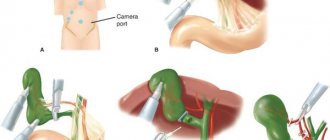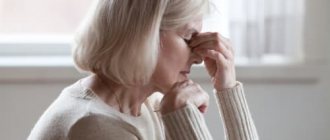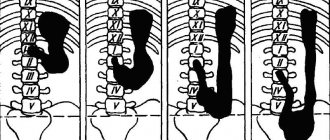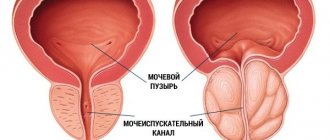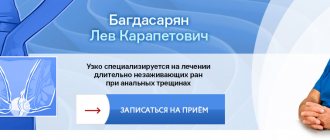Acute calculous cholecystitis is an inflammatory pathology of the gallbladder with the formation of insoluble calculi (stones) in its cavity. This disease is one of the varieties of the pathological process of the human hepatobiliary system, it is called cholelithiasis (GSD). Therefore, the diagnosis often sounds like cholelithiasis, calculous cholecystitis. Pathology with the formation of stones is a fairly common process; it occurs mainly in women of working age.
Etiology (causes)
Stones that form in the lumen of the gallbladder are insoluble compounds. They are mineral salts, bacterial cells, bile salts, they are glued together by thick mucus. The process of their formation is provoked by various reasons, as well as provoking factors, these include:
- Hereditary predisposition.
- Gender – in women, the metabolic processes of the liver are different, so the produced bile has a thicker consistency and is prone to the appearance of sediment.
- Poor nutrition - eating at different times, indulging in fatty, fried foods, and alcohol provoke changes in the chemical composition of bile.
- Increased body weight, which affects the intensity of metabolic processes in the liver, as well as the state of bile.
- Chronic inflammatory process of the mucous membrane of the hepatobiliary system, leading to disruption of the processes of secretion and concentration of bile.
Cholelithiasis, calculous cholecystitis can develop over a long period of time, and the stones increase in size. Also, their number may vary.
Reasons for the development of the disease
Main causes:
- infections of the urinary and reproductive systems - prostatitis, cystitis, etc.;
- diseases of the respiratory tract and ENT organs - bronchitis, sinusitis, pneumonia, etc.;
- infection of the gallbladder ducts by parasites;
- acute or chronic inflammation in the gastrointestinal tract - colitis, dysbacteriosis, etc.
Other risk factors:
- obesity;
- biliary dyskinesia;
- autoimmune diseases;
- reflux of the contents of the duodenum into the gallbladder and bile ducts;
- violation of the composition of bile;
- changes in hormonal levels (pregnancy, menstruation);
- pathologies in the development of the gallbladder;
- abuse of fried, fatty and spicy foods;
- allergy;
- genetic predisposition;
- smoking and alcohol abuse.
Calculous cholecystitis - symptoms
Manifestations of pathology of the gallbladder, structures of the hepatobiliary system with the appearance of stones have characteristic symptoms, they include:
- Feeling of heaviness, pain in the area where the liver is located (right hypochondrium).
- Disruption of the digestive process, which consists of decreased appetite, unstable stools, and bloating.
- Development of jaundice - the skin, mucous membranes, and sclera of the eyes become jaundiced, the intensity of which depends on the severity of the increase in bilirubin. Such jaundice is mechanical; it is provoked by a violation of the outflow of bile from the hepatobiliary system due to blockage by a stone.
- Hepatic colic is a characteristic symptom; it is provoked by the displacement of stones, damage to the mucous membrane by their edges, as well as spasm of the structures of the biliary tract.
The pathology can have a long course with unexpressed clinical manifestations. This is chronic calculous cholecystitis, its course can last from six months or longer.
Symptoms of the disease
The first sign of cholecystitis is pain on the right under the ribs, which can radiate to the arm or under the shoulder blade. They are relieved by analgesics, but return when the medicine stops working.
Other signs of the disease:
- loss of appetite;
- indigestion;
- gas formation;
- chills;
- constant belching and nausea;
- yellowness of the skin.
Symptoms may appear separately or several at the same time. The manifestations of chronic and acute cholecystitis differ.
Signs of chronic cholecystitis:
- yellowness of the skin;
- pain and heaviness in the right hypochondrium, scapula, side;
- lack of appetite, vomiting, nausea that does not go away;
- bitterness in the mouth, constant belching.
Symptoms of an acute attack of cholecystitis:
- sudden weakness;
- bitterness in the mouth;
- sharp pain on the right;
- yellowing of the skin;
- increased heart rate, decreased blood pressure;
- a person cannot take a comfortable position;
- vomiting immediately after eating.
Treatment
After diagnosing the pathology using ultrasound and other methods of visualizing stones, therapy is carried out. It is aimed at surgical removal of stones. Depending on their size, number, nature of the edges, surgery can be performed using open access through an incision in the anterior abdominal wall, as well as laparoscopic techniques (a gentle access method with removal of stones). Also, depending on the severity of the pathology or the presence of complications, stones or the entire gallbladder are removed.
Diagnostic methods
Diagnosis begins with a visit to a gastroenterologist, who collects an anamnesis of the disease and life, and examines the patient. Further laboratory tests are prescribed:
- general urine analysis;
- several blood tests:
- biochemical;
- for sugar;
- for cholesterol;
- for pancreatic amylase;
- for antibodies to parasites;
- clinical.
- stool tests - coprogram, for antibodies to parasites.
To clarify the diagnosis and identify possible concomitant pathologies, the gastroenterologist may prescribe additional examinations:
- Ultrasound of the abdominal cavity;
- ECG;
- ERCP (endoscopic technique);
- MRI or CT with contrast;
- bilioscintigraphy;
- endoscopic ultrasound;
- duodenal intubation;
- bile culture;
- X-ray of the abdominal organs.
Symptoms
In acute cholecystitis, the skin and sclera become yellow
Symptoms of acute phlegmonous calculous cholecystitis are associated with a purulent process, digestive disorders and the appearance of obstructive jaundice.
The disease manifests itself as severe pain in the right hypochondrium, which can spread to adjacent areas of the abdomen and chest. The pain intensifies with breathing, physical activity, and any movement.
Associated symptoms:
- Body temperature is increased.
- Increased weakness, cold sweat.
- The appetite is impaired - as a rule, the patient cannot eat, and fatty foods cause particular disgust.
- Severe vomiting may occur after eating.
- There may be alternation of diarrhea and constipation, with diarrhea the stool is fatty and colorless.
Somewhat later than the general symptoms, signs of jaundice appear - the skin and sclera acquire a yellowish tint, and after 2-3 days the urine turns dark.
As a rule, the patient's condition deteriorates very quickly, so medical attention should be provided as quickly as possible.
Diagnostics
After the first signs of the disease appear, you should seek help from a gastroenterologist. A preliminary diagnosis is made by the attending physician based on the patient’s complaints, taking into account the nature of the described pain, the frequency of its manifestation and other symptoms. You can reliably confirm the diagnosis and determine treatment methods after an ultrasound and blood test. With cholecystitis, especially in the acute period, ESR levels will be increased, and neutrophilic leukocytosis will be detected. Ultrasound diagnostics allows you to visually assess changes in the organ; in advanced stages of cholecystitis, you can notice deformation of the organ and thickening of the walls.
The “gold standard” of diagnosis includes a general clinical analysis of blood, urine, a general stool test for coprogram, a biochemical blood test (liver tests, cholesterol, alkaline phosphatase, amylase, glucose), ultrasound of the hepatobiliary system, ECG, cholecystocholangiography, endoscopic retrograde cholangiopancreatography)
As an additional test, the doctor may order a computed tomography scan of the abdominal cavity and prescribe additional diagnostic examinations.
Diet for gallstone disease
Doctors often revise dietary recommendations, guided by the latest discoveries of scientists. And now, it seems, it’s the turn to change the diet for gallstone disease.
If you have ever been interested in what kind of nutrition is suitable for the treatment of a given disease, then you are probably very familiar with Pevzner’s dietary table No. 5. In general, dietary tables are the most common domestic system of nutritional prescriptions for various diseases today. In particular, the goal of diet No. 5 is to normalize the functioning of the liver, biliary system, fat metabolism, as well as a general gentle attitude towards the digestive system. The fifth diet is easy to find on the Internet if you wish, but we will move on.
You might be surprised, but dietary tables were developed back in the middle of the last century. Since then, world medicine has greatly advanced in its understanding of the nature of diseases. Therefore, in the article I decided to collect modern facts about the effect of nutrition on gallstone disease, which I was able to find in English-language medical scientific journals. Some of these facts are already used in American, European and Australian nutrition manuals, while others still require additional research.
Food allergies
Back in the forties, doctors suggested that food allergies could be the cause of gallbladder disease. This was shown in experiments on various animals: rhesus monkeys, rabbits, etc. One study showed how a diet in which all allergenic foods were excluded from the diet reduced the symptoms of gallstone disease in 100% of subjects in a group of 96 people who have this disease. Unfortunately, such few observations do not allow us to draw global conclusions. However, some practitioners write that they use an individual hypoallergenic diet to treat the symptoms of gallstone disease.
Cholesterol and saturated fat
It is known that cholesterol plays an important role in the process of stone formation—it is what the bulk of the stone consists of. But the link between the disease and a diet rich in saturated fat is still questionable. There are epidemiological data that indicate this: the abundance of cholesterol in the diet of the population is associated with a greater manifestation of symptoms of the disease. At the same time, a diet rich in unsaturated fatty acids (fish oil, oils, nuts, etc.) is associated with a reduced risk of disease. There are not enough observations to draw definitive conclusions about whether additional consumption of unsaturated fats helps in the treatment of gallstone disease.
I found only one study that showed how taking fish oil as a supplement reduced cholesterol in bile by 25% in a group of subjects. This connection requires additional study, but medical practitioners are again ahead of scientists and are already using this principle when preparing the diet of patients.
Vegetarian diet
A 20-year study of 80,898 women found that consuming plant-based protein sources significantly reduced the risk of gallstones. The same connections were found with the active consumption of vegetables and fruits, which is typical for a vegetarian diet. By the way, dietary table No. 5 according to Pevzner also places emphasis on a fiber-rich diet, although the diet is not vegetarian. Fiber has a beneficial effect not on the gallbladder itself, but on the intestines; however, as a result, cholesterol levels are normalized, and this helps patients.
Caffeine
Coffee deserves special attention, or rather, the caffeine it contains. It turns out that consuming it in moderation does not harm, and even helps to reduce the symptoms of gallstone disease. Unlike allergies or cholesterol, the topic of the effect of coffee on gallbladder diseases is being actively studied in both animals and humans. According to a cohort study, drinking this drink reduces the risk of the disease in men by 40–45% and in women by 22–28%, which is significant. However, due to the lack of scientific confidence in the detected effects, the recommendation to indulge in coffee for cholelithiasis is almost never found.
Vitamin C
Some animal experiments have shown that taking vitamin C can prevent gallstone disease. Vitamin C is involved in the process of converting cholesterol into bile acids, preventing the formation of stones and prolonging the period during which they form. The amount of vitamin C used for therapeutic and prophylactic purposes is mentioned differently in different works - from 500 mg to 2 g per day. Although the effectiveness of the use of the vitamin is generally confirmed, the optimal dose has not yet been found - more research is required.
Other products and substances
Read also: Diet for exacerbation of gastritis
Among the products and substances associated with gallstone disease, there are some that have been studied very little, but they are also worth noting. Firstly, these are legumes, including peanuts. In countries where legumes make up a significant part of the population's diet, gallstone disease is less common. A reduction in disease symptoms was also found in those who consumed peanut butter, but only one such study has been conducted. Secondly, there is an assumption that taking iron supplements also helps in treating the disease, but the effect is shown only in animals. Thirdly, lecithin. Scientists hypothesize that consuming lecithin has a positive effect on the chemical composition of the stone. This effect is still being studied, and there is no definitive answer yet. Fourth, alcohol, moderate consumption of which is likely to reduce the risk of stone formation. And finally, there is no definitive evidence yet, but it is likely that consuming added sugar may contribute to the development of the disease. Most likely, indirectly - through increased cholesterol levels or obesity.
Compare with diet No. 5
Now let's see if the latest data contradicts how dietary table No. 5 works. The first thing you can pay attention to is coffee. In the mentioned diet it is excluded, while coffee can be a healing factor. The same applies to alcohol - it is categorically excluded in any quantities, although its positive effect is rather shown in small doses.
Diet 5 also eliminates legumes as a source of crude fiber. It has not yet been conclusively proven, but there is a possibility that this is being done in vain. And avoiding fatty fish seems even less justified, given the role of unsaturated acids in maintaining optimal cholesterol levels.
But regarding the previously mentioned fiber from vegetables and fruits, as well as fatty animal meat and fatty dairy products, there is amazing unanimity among nutritionists. Apples and carrots have the green light, but it’s better to abstain from steaks and sour cream.
Maria Danina
Photo thinkstockphotos.com
Treatment of the disease
General principles of therapy:
- taking antibiotics;
- diet;
- physiotherapy;
- symptomatic therapy to alleviate the general condition.
In the chronic form of cholecystitis, treatment can be not only medicinal, but also surgical. Complex drug therapy includes the following groups of drugs:
- choleretic;
- antibiotics;
- digestive enzymes;
- prokinetics;
- non-steroidal anti-inflammatory drugs;
- antispasmodics;
- lacto- and bifidobacteria.
Surgical treatment is used when acute inflammation cannot be relieved with medications. In this case, the affected part of the gallbladder is removed.
